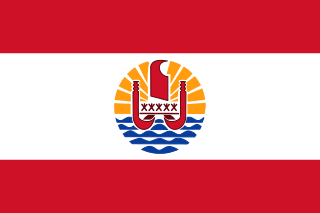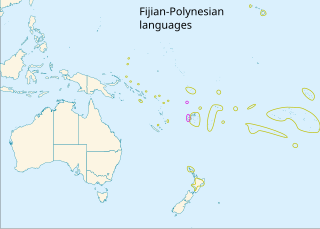Related Research Articles

French Polynesia is an overseas collectivity of France and its sole overseas country. It comprises 121 geographically dispersed islands and atolls stretching over more than 2,000 kilometres (1,200 mi) in the South Pacific Ocean. The total land area of French Polynesia is 3,521 square kilometres (1,359 sq mi), with a population of 278,786 of which at least 205,000 live in the Society Islands and the remaining population lives in the rest of the archipelago.

The Polynesian languages form a genealogical group of languages, itself part of the Oceanic branch of the Austronesian family.

Tubuai, Tubuaʻi or Tupuaʻi is the main island of the Austral Island group, located 640 km (400 mi) south of Tahiti. In addition to Tubuai, the group of islands include Rimatara, Rurutu, Raivavae, Rapa and the uninhabited Îles Maria. They are part of the Austral Islands in the far southwest of French Polynesia in the south Pacific Ocean. Tubuai island sustains a population of 2,185 people on 45 km2 of land. Due to its southerly position, Tubuai has notably cooler weather than Tahiti.

The flag of French Polynesia is the civil and state flag of the French overseas country French Polynesia. It was adopted in 1984. According to the articles of adoption, the flag of French Polynesia must be displayed with the French tricolor, and may be displayed with the flags of the component archipelagos. The French Polynesian flag must be displayed to the left of the French flag, and the flag of the archipelago must be displayed to its right.
Tahitian is a Polynesian language, spoken mainly on the Society Islands in French Polynesia. It belongs to the Eastern Polynesian group.

The Austral Islands are the southernmost group of islands in French Polynesia, an overseas country of the French Republic in the South Pacific. Geographically, they consist of two separate archipelagos, namely in the northwest the Tupua'i islands consisting of the Îles Maria, Rimatara, Rūrutu, Tupua'i Island proper and Ra'ivāvae, and in the southeast the Bass Islands composed of the main island of Rapa Iti and the small Marotiri. Inhabitants of the islands are known for their pandanus fiber weaving skills. The islands of Maria and Marotiri are not suitable for sustained habitation. Several of the islands have uninhabited islets or rocks off their coastlines. Austral Islands' population is 6,965 on almost 150 km2 (58 sq mi). The capital of the Austral Islands administrative subdivision is Tupua'i.
Marquesan is a collection of East-Central Polynesian dialects, of the Marquesic group, spoken in the Marquesas Islands of French Polynesia. They are usually classified into two groups, North Marquesan and South Marquesan, roughly along geographic lines.
Rapa is the language of Rapa Iti, in the Austral Islands of French Polynesia, and of Mangaia in the Cook Islands. It is an Eastern Polynesian language. There are three varieties of the Rapa language currently being spoken in French Polynesia: Old Rapa, Reo Rapa and New Rapa. Old Rapa has been mostly replaced by Reo Rapa, a mix of the more commonly spoken Tahitian and Old Rapa. New Rapa – revitalized Old Rapa – is commonly spoken by middle-aged and younger speakers. Rapa is a critically endangered language, and there are only around 300 speakers of Reo Rapa, with only 15% of them able to speak Old Rapa. It may be more vibrant on Mangaia, but there the population has been declining for half a century due to emigration.
Himene tarava is a style of traditional Tahitian music.
Proto-Polynesian is the hypothetical proto-language from which all the modern Polynesian languages descend. It is a daughter language of the Proto-Austronesian language. Historical linguists have reconstructed the language using the comparative method, in much the same manner as with Proto-Indo-European and Proto-Uralic. This same method has also been used to support the archaeological and ethnographic evidence which indicates that the ancestral homeland of the people who spoke Proto-Polynesian was in the vicinity of Tonga, Samoa, and nearby islands.
Tuamotuan, Paʻumotu or Paumotu is a Polynesian language spoken by 4,000 people in the Tuamotu archipelago, with an additional 2,000 speakers in Tahiti.
Rimatara is the westernmost inhabited island in the Austral Islands of French Polynesia. It is located 550 km (340 mi) south of Tahiti and 150 km (93 mi) west of Rurutu. The land area of Rimatara is 8.6 km2 (3.3 sq mi), and that of the Maria islets is 1.3 km2 (0.50 sq mi). Its highest point is 106 m (348 ft). Its population was 893 at the 2022 census.
Mangareva, Mangarevan is a Polynesian language spoken by about 600 people in the Gambier Islands of French Polynesia and by Mangarevians emigrants on the islands of Tahiti and Moorea, located 1,650 kilometres (1,030 mi) to the North-West of the Gambier Islands.

Îles Maria or simply Maria, also known as Hull Island, is a small coral atoll in the Pacific Ocean. Its original name is Nororotu. The nearest island is Rimatara situated 205 kilometres to the ESE.
Glochidion raivavense, also known by its synonym Phyllanthus raivavense or by the local name mahame on the island of Tubuai, is a species of plant in the family Phyllanthaceae. It is endemic to the Austral Islands in French Polynesia, where it is native to the islands of Rurutu, Tubuai, and Raivavae.

This page list topics related to French Polynesia.

Teuruarii IV, born Epatiana a Teuruarii, was the last King of Rurutu, an island within the larger Austral Islands archipelago, who ruled from around 1886 until the annexation of the island to France in 1900. Proclaimed king upon his father's abdication while still a child, his mother ruled as regent. During this regency the Church of Moerari was consecrated and the death penalty was abolished.

Tamaeva V or Temaeva V, formally Heimataura Tamatoa Tamaeva V, was the Arii vahine no Rimatara or queen of the island kingdom of Rimatara, an island within the larger Austral Islands archipelago, from 1892 to 1901. She served as regent for her predecessor Queen Tamaeva IV.
Nuguria (Nukuria) is a Polynesian language, spoken by approximately 550 people on Nuguria in the eastern islands of Papua New Guinea. The language was taught in primary schools in Nuguria and was used for daily communications between adults and children. Nuguria is one of the eighteen small islands to the east of Papua New Guinea, which are known as the Polynesian Outliers. The Nukuria language has been concluded to be closely related to other nearby languages such as Nukumanu, Takuu, Nukuoro, and Luangiua. Research on the Nuguria Atoll and the language itself is scarce; past research demonstrated that this language was at risk of potential endangerment. The language was only then classified as at risk of endangerment because it was still used between generations and was passed on to the children. However, recent research indicates that Nukuria is now most likely an extinct language.

French Polynesia's 2nd constituency is a French legislative constituency in French Polynesia. It is currently represented by Nicole Sanquer of A here ia Porinetia.
References
- 1 2 3 4 5 6 Austral at Ethnologue (25th ed., 2022)

- ↑ "Tubuai-Rurutu facts". www2.ling.su.se. Archived from the original on 2018-03-01. Retrieved 2018-09-28.
- ↑ Hermann, Aymeric; Boltt, Robert; Conte, Eric (2015). "The Atiahara site revisited: An early coastal settlement in Tubuai (Austral Islands, French Polynesia)". Archaeology in Oceania. 51 (1): 31–44. doi:10.1002/arco.5070.
- ↑ Greg Dening (1 March 1994). Mr Bligh's Bad Language: Passion, Power and Theatre on the Bounty. Cambridge University Press. pp. 88–92. ISBN 978-0-521-46718-6 . Retrieved 27 November 2011.
- ↑ Caroline Alexander (1 May 2004). The Bounty: The True Story of the Mutiny on the Bounty . Penguin. pp. 13–14. ISBN 978-0-14-200469-2 . Retrieved 27 November 2011.
- ↑ David Stanley (1985). South Pacific Handbook. David Stanley. pp. 116–. ISBN 978-0-918373-05-2 . Retrieved 25 November 2011.
- ↑ "Detailed description of Toobouai by James Morrison". Archived from the original on 7 April 2016. Retrieved 2011-12-28.
- 1 2 Daniel Tyerman; George Bennet; London Missionary Society (1831). Journal of voyages and travels by the Rev. Daniel Tyerman and George Bennet, esq: Deputed from the London Missionary Society, to visit their various stations in the South sea islands, China, India, &c., between the years 1821 and 1829. Frederick Westley and A. H. Davis. pp. 75–. Retrieved 29 December 2011.
- ↑ Christian, Glynn (2005). Fragile Paradise: The Discovery of Fletcher Christian, Bounty Mutineer. p. 222. ISBN 978-1-59048-250-6.
- ↑ Hinz, Earl R.; Howard, Jim (2006). Landfalls of Paradise: Cruising Guide to the Pacific Islands. University of Hawaii Press. p. 108. ISBN 978-0-8248-3037-3.
- ↑ Bacchet, P. (6 March 2017). "Tubuai: The Island of Contrast" . Retrieved 2 October 2018.
- 1 2 3 4 5 6 Charpentier, Jean-Michel; François, Alexandre (2015). Atlas Linguistique de Polynésie Française — Linguistic Atlas of French Polynesia. Mouton de Gruyter & Université de la Polynésie Française. ISBN 978-3-11-026035-9.
- ↑ "Austronesian". www.languagesgulper.com. Retrieved 2018-09-28.
- ↑ Lee, Nala Huiying (17 March 2015). "Assessing levels of endangerment in the Catalogue of Endangered Languages (ELCat) using the Language Endangerment Index (LEI)" (PDF). Retrieved 3 October 2018.
- ↑ Trudgill, Peter (2004). "Linguistic and social typology: The Austronesian migrations and phoneme inventories" (PDF). Linguistic Typology. 8 (3). doi:10.1515/lity.2004.8.3.305. S2CID 120353858.
- ↑ "Verbix Languages Languages/Austral". wiki.verbix.com. Archived from the original on 2018-10-19. Retrieved 2018-10-19.